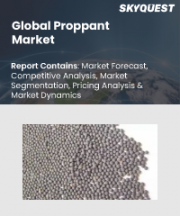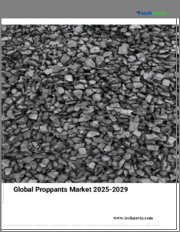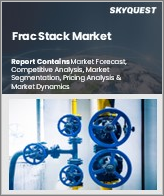
|
시장보고서
상품코드
1859459
프로판트 시장 규모, 점유율, 성장 분석 : 유형별, 용도별, 최종 용도 산업별, 지역별 - 산업 예측(2025-2032년)Proppant Market Size, Share, and Growth Analysis, By Type (Frac Sand, Ceramic Proppants), By Application (Shale Gas, Tight Gas), By End Use Industry, By Region - Industry Forecast 2025-2032 |
||||||
프로판트 시장 규모는 2023년에 86억 달러로 평가되며, 2024년 93억 6,000만 달러에서 2032년에는 183억 7,000만 달러로 성장하며, 예측 기간(2025-2032년)의 CAGR은 8.8%로 성장할 전망입니다.
프로판트 시장은 석유 및 가스 부문의 수압파쇄 수요 증가에 힘입어 큰 폭으로 성장하고 있습니다. 이러한 재료는 유정에서 석유 및 가스 생산을 강화하는 데 필수적인 프래킹 과정에서 발생하는 균열의 무결성을 유지하는 데 중요한 역할을 합니다. 자원 채굴을 최적화하기 위해 수압파쇄 기술이 보급됨에 따라 고품질 프로판트의 필요성은 계속 증가할 것입니다. 프로판트와 파쇄 유체의 통합은 탄화수소의 지속적인 흐름을 촉진하고 균열이 열린 상태로 효과적으로 유지되도록 보장합니다. 이러한 역학은 프로판 시장의 혁신과 투자를 촉진하고 석유 및 가스 사업의 전반적인 효율성과 생산성에 있으며, 그 중요성을 강조하고 있습니다.
프로판트 시장 부문 분석
세계의 프로판트 시장은 유형별, 용도별, 최종 용도 산업별, 지역별로 구분됩니다. 유형별로는 플라크샌드(백사, 차사), 레진코팅 프로판트(프리큐어 레진코팅, 경화성 레진코팅), 세라믹 프로판트(저밀도, 중밀도, 고밀도)로 구분됩니다. 용도별로는 셰일가스, 타이트 가스, 탄층메탄, 기타(오일샌드, 기존형 석유 및 가스)로 구분됩니다. 최종 용도 산업별로 시장은 석유 및 가스 탐사(수압파쇄, 석유증진회수(EOR)), 건설(콘크리트 첨가제, 도로건설), 기타(물 여과, 주조)로 구분됩니다. 지역별로는 북미, 유럽, 아시아태평양, 라틴아메리카, 중동 및 아프리카로 구분됩니다.
프로판트 시장 성장 촉진요인
수평 시추와 다단 파쇄 기술의 발전으로 세계 석유 및 가스 생산 상황은 크게 변화하고 있습니다. 탐사 및 생산업체들은 수평정 시추 및 완공에 많은 모래를 사용하고 있으며, 이러한 추세는 더욱 가속화될 것으로 예측됩니다. 횡갱당 평균 모래 소비량은 횡갱의 길이가 길어지고 횡갱 1피트당 모래 충전량이 증가함에 따라 크게 증가하고 있으며, 이러한 증가 추세는 앞으로도 지속될 것으로 예측됩니다. 이러한 시추용 프로판 수요 증가는 세라믹 대체재보다 천연 모래와 프랙샌드의 우선 사용을 목적으로 하는 기술 혁신이 진행되고 있는 것이 주요 원인입니다.
프로판트 시장 성장 억제요인
세라믹 프로판의 생산은 소결 보크사이트, 카올린, 규산 마그네슘, 규산 마그네슘 또는 이들의 조합과 같은 재료가 관여하는 매우 에너지 소모적인 공정에 의존합니다. 이러한 프로판트가 효과적으로 프로판트 층의 다공성과 투과성을 높이기 위해서는 제조 단계 내내 일관된 크기, 모양, 진원도, 진원도를 유지하는 것이 매우 중요합니다. 이러한 특성의 편차는 수압파쇄 용도에서 프로판트의 성능과 효율성에 악영향을 미칠 수 있으므로 이 문제는 매우 중요합니다. 그 결과, 생산에 대한 에너지 수요와 정밀도의 필요성이 프로판트 시장의 잠재적 제약 요인으로 작용하고 있습니다.
프로판트 시장 동향
프로판트 시장에서는 수압파쇄 작업의 주요 선택지로 등장한 프랙트샌드(Fracted Sand)로의 전환이 두드러지고 있습니다. 이러한 선호도는 우물을 효과적으로 자극하는 데 필수적인 인상적인 강도와 순도를 특징으로 하는 둥근 입자의 석영 모래 고유의 특성에 기인합니다. 파쇄 모래의 구성에 사암이 많이 포함되어 있는 것이 그 성능에 기여하여 석유 및 가스 산업에서 수요가 증가하고 있습니다. 채굴 기술이 발전함에 따라 비용 효율성과 작업 효율성이 강조되면서 파쇄 모래의 사용은 더욱 강화되어 시장 상황의 중요한 촉진요인으로 자리 매김하고 있습니다.
목차
서론
- 조사의 목적
- 조사 범위
- 정의
조사 방법
- 정보 조달
- 2차와 1차 데이터 방법
- 시장 규모 예측
- 시장의 전제조건과 제한
개요
- 세계 시장 전망
- 공급과 수요 동향 분석
- 부문별 기회 분석
시장 역학과 전망
- 시장 개요
- 시장 규모
- 시장 역학
- 촉진요인과 기회
- 억제요인과 과제
- 포타즈 분석과 영향
- 경쟁 기업 간 경쟁 관계
- 대체품의 위협
- 바이어의 교섭력
- 신규 진출업체의 위협
- 공급 기업의 교섭력
주요 시장 인사이트
- 주요 성공 요인
- 경쟁의 정도
- 주요 투자 기회
- 시장 에코시스템
- 시장의 매력 지수(2024년)
- PESTEL 분석
- 거시경제 지표
- 밸류체인 분석
- 가격 분석
- 규제 상황
- 사례 연구
세계의 프로판트 시장 규모 : 유형별, CAGR(2025-2032년)
- 시장 개요
- 프랙샌드
- 백사
- 갈색 모래
- 수지 코팅 프로판트
- 프리 큐어 레진 코트
- 경화성 수지 코팅
- 세라믹 프로판트
- 저밀도
- 중밀도
- 고밀도
세계의 프로판트 시장 규모 : 용도별, CAGR(2025-2032년)
- 시장 개요
- 셰일가스
- 타이트 가스
- 석탄층 메탄
- 기타
- 오일 샌드
- 전통 석유 및 가스
세계의 프로판트 시장 규모 : 최종 용도 산업별, CAGR(2025-2032년)
- 시장 개요
- 석유 및 가스 탐사
- 수압파쇄
- 석유회수증진법(EOR)
- 건설
- 콘크리트 첨가제
- 도로 건설
- 기타
- 물여과
- 파운드리
세계의 프로판트 시장 규모 : 지역별, CAGR(2025-2032년)
- 북미
- 미국
- 캐나다
- 유럽
- 영국
- 독일
- 스페인
- 프랑스
- 이탈리아
- 기타 유럽 지역
- 아시아태평양
- 중국
- 인도
- 일본
- 한국
- 기타 아시아태평양
- 라틴아메리카
- 브라질
- 기타 라틴아메리카 지역
- 중동 및 아프리카
- GCC 국가
- 남아프리카공화국
- 기타 중동 및 아프리카
경쟁 정보
- 상위 5사의 비교
- 주요 기업의 시장 포지셔닝(2024년)
- 주요 시장 기업이 채택한 전략
- 최근 시장 동향
- 기업의 시장 점유율 분석(2024년)
- 주요 기업의 기업 개요
- 기업의 상세
- 제품 포트폴리오 분석
- 기업의 부문별 점유율 분석
- 매출의 전년대비 비교(2021-2023)
주요 기업 개요
- Carbo Ceramics Inc.(US)
- Covia Holdings Corporation(US)
- U.S. Silica Holdings, Inc.(US)
- Hi-Crush Inc.(US)
- JSC Borovichi Refractories Plant(Russia)
- Badger Mining Corporation(US)
- Smart Sand Inc.(US)
- Preferred Sands(US)
- Pioneer Natural Resources Company(US)
- Saint-Gobain Proppants(France)
- Fairmount Santrol(US)
- Atlas Sand Company, LLC(US)
- Vista Proppants and Logistics, LLC(US)
- Emerge Energy Services LP(US)
- Mineracao Curimbaba Ltd(Brazil)
- Superior Silica Sands LLC(US)
- Fores Ltd.(Canada)
- China Gengsheng Minerals, Inc.(China)
- Hexion Inc.(US)
- Momentive Specialty Chemicals Inc.(US)
결론과 제안
KSAProppant Market size was valued at USD 8.6 Billion in 2023 and is poised to grow from USD 9.36 Billion in 2024 to USD 18.37 Billion by 2032, growing at a CAGR of 8.8% during the forecast period (2025-2032).
The proppant market is experiencing significant growth fueled by the increasing demand for hydraulic fracturing in the oil and gas sector. These materials play a crucial role in maintaining the integrity of the fractures created during fracking, which are essential for enhancing oil and gas production from wells. As hydraulic fracturing techniques become more widespread to optimize resource extraction, the necessity for high-quality proppants will continue to rise. The integration of proppants with fracturing fluids facilitates the sustained flow of hydrocarbons, ensuring that fissures remain open and effective. This dynamic is driving innovation and investment within the proppant market, highlighting its importance in the overall efficiency and productivity of oil and gas operations.
Top-down and bottom-up approaches were used to estimate and validate the size of the Proppant market and to estimate the size of various other dependent submarkets. The research methodology used to estimate the market size includes the following details: The key players in the market were identified through secondary research, and their market shares in the respective regions were determined through primary and secondary research. This entire procedure includes the study of the annual and financial reports of the top market players and extensive interviews for key insights from industry leaders such as CEOs, VPs, directors, and marketing executives. All percentage shares split, and breakdowns were determined using secondary sources and verified through Primary sources. All possible parameters that affect the markets covered in this research study have been accounted for, viewed in extensive detail, verified through primary research, and analyzed to get the final quantitative and qualitative data.
Proppant Market Segments Analysis
Global Proppant Market is segmented by type, application, end use industry and region. Based on type, the market is segmented into frac sand (white sand, brown sand), resin-coated proppants (pre-cured resin coated, curable resin coated) and ceramic proppants (low density, medium density, high density). Based on application, the market is segmented into shale gas, tight gas, coalbed methane and others (oil sands, conventional oil & gas). Based on end use industry, the market is segmented into oil & gas exploration (hydraulic fracturing, enhanced oil recovery (EOR)), construction (concrete additives, road construction) and others (water filtration, foundry). Based on region, the market is segmented into North America, Europe, Asia Pacific, Latin America and Middle East & and Africa.
Driver of the Proppant Market
The global oil and gas production landscape has transformed significantly due to advancements in horizontal drilling and multistage fracturing techniques. Exploration and production companies are increasingly using more sand for drilling and completing horizontal wells, a trend anticipated to accelerate. The average consumption of sand per horizontal well has seen a substantial increase, driven by longer lateral lengths and enhanced loadings per lateral foot, and this upward trajectory is expected to continue. This growing demand for drilling proppants is largely attributed to the ongoing innovations aimed at favoring the use of natural sand or frac sand over ceramic alternatives.
Restraints in the Proppant Market
The production of ceramic proppants relies on a highly energy-consuming process involving materials such as sintered bauxite, kaolin, and magnesium silicate, or their combinations. For these proppants to effectively enhance the porosity and permeability of the proppant bed, it is crucial that they maintain a consistent size, shape, sphericity, and roundness throughout the manufacturing phase. This requirement presents a significant challenge, as any variations in these characteristics can adversely affect the performance and efficiency of the proppants in hydraulic fracturing applications. Consequently, the energy demands and need for precision in production contribute to potential constraints within the proppant market.
Market Trends of the Proppant Market
The proppant market is experiencing a notable shift towards frac sand, which has emerged as the predominant choice for hydraulic fracturing operations. This preference is driven by the inherent properties of round-grain quartz sand, characterized by its impressive strength and purity, essential for effective well stimulation. The predominance of sandstone in the composition of frac sand contributes to its performance, fueling its demand in the oil and gas industries. As extraction techniques evolve, the emphasis on cost-effectiveness and operational efficiency further bolsters the use of frac sand, solidifying its position as a key driver in the proppant market landscape.
Table of Contents
Introduction
- Objectives of the Study
- Scope of the Report
- Definitions
Research Methodology
- Information Procurement
- Secondary & Primary Data Methods
- Market Size Estimation
- Market Assumptions & Limitations
Executive Summary
- Global Market Outlook
- Supply & Demand Trend Analysis
- Segmental Opportunity Analysis
Market Dynamics & Outlook
- Market Overview
- Market Size
- Market Dynamics
- Driver & Opportunities
- Restraints & Challenges
- Porters Analysis & Impact
- Competitive rivalry
- Threat of substitute
- Bargaining power of buyers
- Threat of new entrants
- Bargaining power of suppliers
Key Market Insights
- Key Success Factors
- Degree of Competition
- Top Investment Pockets
- Market Ecosystem
- Market Attractiveness Index, 2024
- PESTEL Analysis
- Macro-Economic Indicators
- Value Chain Analysis
- Pricing Analysis
- Regulatory Landscape
- Case Studies
Global Proppant Market Size by Type & CAGR (2025-2032)
- Market Overview
- Frac Sand
- White Sand
- Brown Sand
- Resin-Coated Proppants
- Pre-cured Resin Coated
- Curable Resin Coated
- Ceramic Proppants
- Low Density
- Medium Density
- High Density
Global Proppant Market Size by Application & CAGR (2025-2032)
- Market Overview
- Shale Gas
- Tight Gas
- Coalbed Methane
- Others
- Oil Sands
- Conventional Oil & Gas
Global Proppant Market Size by End Use Industry & CAGR (2025-2032)
- Market Overview
- Oil & Gas Exploration
- Hydraulic Fracturing
- Enhanced Oil Recovery (EOR)
- Construction
- Concrete Additives
- Road Construction
- Others
- Water Filtration
- Foundry
Global Proppant Market Size & CAGR (2025-2032)
- North America, (Type, Application, End Use Industry)
- US
- Canada
- Europe, (Type, Application, End Use Industry)
- UK
- Germany
- Spain
- France
- Italy
- Rest of Europe
- Asia-Pacific, (Type, Application, End Use Industry)
- China
- India
- Japan
- South Korea
- Rest of Asia Pacific
- Latin America, (Type, Application, End Use Industry)
- Brazil
- Rest of Latin America
- Middle East & Africa, (Type, Application, End Use Industry)
- GCC Countries
- South Africa
- Rest of Middle East & Africa
Competitive Intelligence
- Top 5 Player Comparison
- Market Positioning of Key Players, 2024
- Strategies Adopted by Key Market Players
- Recent Developments in the Market
- Company Market Share Analysis, 2024
- Company Profiles of All Key Players
- Company Details
- Product Portfolio Analysis
- Company's Segmental Share Analysis
- Revenue Y-O-Y Comparison (2021-2023)
Key Company Profiles
- Carbo Ceramics Inc. (US)
- Company Overview
- Business Segment Overview
- Financial Updates
- Key Developments
- Covia Holdings Corporation (US)
- Company Overview
- Business Segment Overview
- Financial Updates
- Key Developments
- U.S. Silica Holdings, Inc. (US)
- Company Overview
- Business Segment Overview
- Financial Updates
- Key Developments
- Hi-Crush Inc. (US)
- Company Overview
- Business Segment Overview
- Financial Updates
- Key Developments
- JSC Borovichi Refractories Plant (Russia)
- Company Overview
- Business Segment Overview
- Financial Updates
- Key Developments
- Badger Mining Corporation (US)
- Company Overview
- Business Segment Overview
- Financial Updates
- Key Developments
- Smart Sand Inc. (US)
- Company Overview
- Business Segment Overview
- Financial Updates
- Key Developments
- Preferred Sands (US)
- Company Overview
- Business Segment Overview
- Financial Updates
- Key Developments
- Pioneer Natural Resources Company (US)
- Company Overview
- Business Segment Overview
- Financial Updates
- Key Developments
- Saint-Gobain Proppants (France)
- Company Overview
- Business Segment Overview
- Financial Updates
- Key Developments
- Fairmount Santrol (US)
- Company Overview
- Business Segment Overview
- Financial Updates
- Key Developments
- Atlas Sand Company, LLC (US)
- Company Overview
- Business Segment Overview
- Financial Updates
- Key Developments
- Vista Proppants and Logistics, LLC (US)
- Company Overview
- Business Segment Overview
- Financial Updates
- Key Developments
- Emerge Energy Services LP (US)
- Company Overview
- Business Segment Overview
- Financial Updates
- Key Developments
- Mineracao Curimbaba Ltd (Brazil)
- Company Overview
- Business Segment Overview
- Financial Updates
- Key Developments
- Superior Silica Sands LLC (US)
- Company Overview
- Business Segment Overview
- Financial Updates
- Key Developments
- Fores Ltd. (Canada)
- Company Overview
- Business Segment Overview
- Financial Updates
- Key Developments
- China Gengsheng Minerals, Inc. (China)
- Company Overview
- Business Segment Overview
- Financial Updates
- Key Developments
- Hexion Inc. (US)
- Company Overview
- Business Segment Overview
- Financial Updates
- Key Developments
- Momentive Specialty Chemicals Inc. (US)
- Company Overview
- Business Segment Overview
- Financial Updates
- Key Developments




















